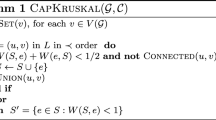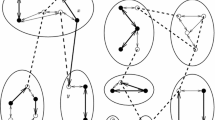Abstract
Given a wireless network, we want to assign each node a transmission power, which will enable transmission between any two nodes (via other nodes). Moreover, due to possible faults, we want to have at least k vertex-disjoint paths from any node to any other, where k is some fixed integer, depending on the reliability of the nodes. The goal is to achieve this directed k-strong connectivity with a minimal overall power assignment. The problem is NP-Hard for any k ≥ 1 already for planar networks. Here we first present an optimal power assignment for uniformly spaced nodes on a line for any k ≥ 1. We also prove a number of useful properties of power assignment which are also of independent interest. Based on it, we design an approximation algorithm for linear radio networks with factor \(\hbox{min}\left\{2,\left(\frac {\Updelta} {\delta}\right)^\alpha \right\},\) where Δ and δ are the maximal and minimal distances between adjacent nodes respectively and parameter α ≥ 1 being the distance-power gradient. We then extend it to the weighted version. Finally, we develop an approximation algorithm with factor O(k 2), for planar case, which is, to the best of our knowledge, the first non-trivial result for this problem.











Similar content being viewed by others
Notes
A Hamiltonian cycle is a graph cycle (i.e., closed loop) through a graph that visits each node exactly once. A graph possessing a Hamiltonian circuit is said to be a Hamiltonian graph or simply Hamiltonian.
It is also easy to verify that r = 2α−1 for any α ≥ 2.
Square of graph G = (V,E) is a graph G 2 = (V,E 2), where e = (u,v) ∈ E 2 if there is a path in G from u to v using at most 2 edges.
References
Ambuhl, C., Clementi, A., Ianni, M., Rossi, G., Monti, A., & Silvestri, R. (2004). The range assignment problem in non-homogeneous static ad-hoc networks. In Proceedings of the 2nd international conference on AD-HOC networks and wireless (AdHoc-Now 03).
Bender, M. A., & Chekuri, C. (2000). Performance guarantees for the TSP with a parameterized triangle inequality. Information Processing Letters, 73(1–2), 17–21.
Pahlavan, K., & Levesque, A. (1995). Wireless information networks. Wiley-Interscience.
Krumke, S. O., Liu, R., Lloyd, E. L., Marathe, M. V., Ramanathan, R., & Ravi, S. S. (2003). Topology control problems under symmetric and asymmetric power thresholds. In ADHOC-NOW 2003 (pp. 187–198).
Deb, B., & Nath, B. (2005). On the node-scheduling approach to topology control in ad hoc networks. In MobiHoc’05 (pp. 14–26).
ElBatt, T. A., & Ephremides, A. (2002). Joint scheduling and power control for wireless ad-hoc networks. In INFOCOM (pp. 976—984).
Wieselthier, J. E., Nguyen, G. D, & Ephremides, A. (2001). Algorithms for energy-efficient multicasting in static ad hoc wireless networks. MONET, 6(3), 251–263.
Kirousis, L. M., Kranakis, E., Krizanc, D., & Pelc, A. (2000). Power consumption in packet radio networks. Theoretical Computer Science, 243(1–2), 289–305.
Clementi, A. E. F., Penna, P., & Silvestri, R. (1999). Hardness results for the power range assignment problem in packet radio networks. In Proceedings of the 2nd international workshop on approximation algorithms for combinatorial optimization problems (APPROX) (pp. 197–208).
Ambuhl, C., Clementi, A., Penna, P., Rossi, G., & Silvestri, R. (2003). Energy consumption in radio networks: Selfish agents and rewarding mechanisms. In Proceedings of the 10th international colloquium on structural information & communication complexity (SIROCCO) (pp. 1–16).
Clementi, A. E. F., Ferreira, A., Penna, P., Perennes, S., & Silvestri, R. (2000). The minimum range assignment problem on linear radio networks. In European symposium on algorithms (pp. 143–154).
Clementi, A. E. F., Penna, P., & Silvestri, R. (2000). On the power assignment problem in radio networks. Electronic colloquium on computational complexity (ECCC).
Clementi, A. E. F., Penna, P., & Silvestri, R. (2000). The power range assignment problem in radio networks on the plane. In Proceedings of the 17th annual symposium on theoretical aspects of computer science (pp. 651–660).
Blough, D., Leoncini, M., Resta, G., & Santi, P. (2002). On the symmetric range assignment problem in wireless ad hoc networks. In Proceedings of the 2nd IFIP international conference on theoretical computer science (TCS) (pp. 71–82).
Calinescu, G., Mandoiu, I., & Zelikovsly, A. (2002). Symmetric connectivity with minimum power consumption in radio networks. In Proceedings of the 2nd IFIP international conference on theoretical computer science (pp. 119–130).
Althaus, E., Calinescu, G., Mandoiu, I., Prasad, S., Tchervenski, N., & Zelikovsly, A. (2003). Power efficient range assignment in ad-hoc wireless networks. In IEEE wireless communications and networking conference (WCNC03).
Clementi, A. E. F., Huiban, G., Penna, P., Rossi, G., & Verhoeven, Y. C. (2003). Some recent theoretical advances and open questions on energy consumption in ad-hoc wireless networks. In Proceedings of the 3rd workshop on approximation and randomization algorithms in communication networks.
Calinescu, G., & Wan, P. J. (2003). Range assignment for high connectivity in wireless ad hoc networks. In Proceedings of the 2nd international conference on AD-HOC networks and wireless (AdHoc-Now 03) (pp. 235–246).
Hajiaghayi, M. T., Immorlica, N., & Mirrokni, V. S. (2003). Power optimization in fault-tolerant topology control algorithms for wireless multi-hop networks. In Proceedings of the 9th annual international conference on mobile computing and networking (pp. 300–312).
Jia, X., Kim, D., Wan, P., & Yi, C. (2005). Power assignment for k-connectivity in wireless ad hoc networks. In Proceedings of the IEEE INFOCOM.
Hajiaghayi, M. T., Kortsarz, G., Mirrokni, V. S., & Nutov, Z. (2005). Power optimization for connectivity problems. In Proceedings of IPCO.
Lloyd, E. L., Liu, R., Marathe, M.V., Ramanathan, R., & Ravi, S. S. (2005). Algorithmic aspects of topology control problems for ad hoc networks. MONET, 10(1–2), 19–34.
Clementi, A. E. F., Crescenzi, P., Penna, P., Rossi, G., & Vocca, P. (2001). On the complexity of computing minimum energy consumption broadcast subgraphs. In Proceedings of the 18th annual symposium on theoretical aspects of computer science (pp. 121–131).
Huiban, G., & Verhoeven, Y. C. (2002). A self-stabilized distributed algorithm for the range assignment in ad-hoc wireless networks. Soumis Parallel Processing Letters, 14(4), 426–433.
Wan, P. J., Calinescu, G., Li, X. Y., & Frieder, O. (2002). Minimum-energy broadcast routing in static ad hoc wireless networks. ACM Wireless Networks, 8(6), 607–617.
Wieselthier, J., Nguyen, G., & Ephremides, A. (2000). On the construction of energy-efficient broadcast and multicast trees in wireless networks. In Proceedings of the IEEE INFOCOM (pp. 586–594).
Srinivas, A., & Modiano, E. (2003). Minimum energy disjoint path routing in wireless ad-hoc. In Proceedings of the 9th annual international conference on mobile computing and networking (pp. 122–133).
Segal, M., & Kedem, K. (1997). Geometric applications of posets. In WADS (pp. 402–417).
Chvatal, V., & Erdos, P. (1972). A note on Hamiltonian circuits. Discrete Mathematics, 2, 111–113.
Acknowledgements
The authors wish to thank Daniel Berend for long and fruitful discussions, valuable suggestions and a lot of help and support. The authors would also like to thank anonymous reviewers for their helpful comments that improved the paper. Hanan Shpungin has been supported in part by the Lynn and William Frankel Center for Computer Sciences. Work by Michael Segal has been supported by REMON (4G networking) consortium.
Author information
Authors and Affiliations
Corresponding author
Additional information
Preliminary version of this paper has been appeared at ACM/SIGMOBILE International Workshop on Foundation of Mobile Computing DIALM-POMC’05.
Rights and permissions
About this article
Cite this article
Shpungin, H., Segal, M. On minimizing the total power of k-strongly connected wireless networks. Wireless Netw 16, 1075–1089 (2010). https://doi.org/10.1007/s11276-009-0189-7
Received:
Accepted:
Published:
Issue Date:
DOI: https://doi.org/10.1007/s11276-009-0189-7




